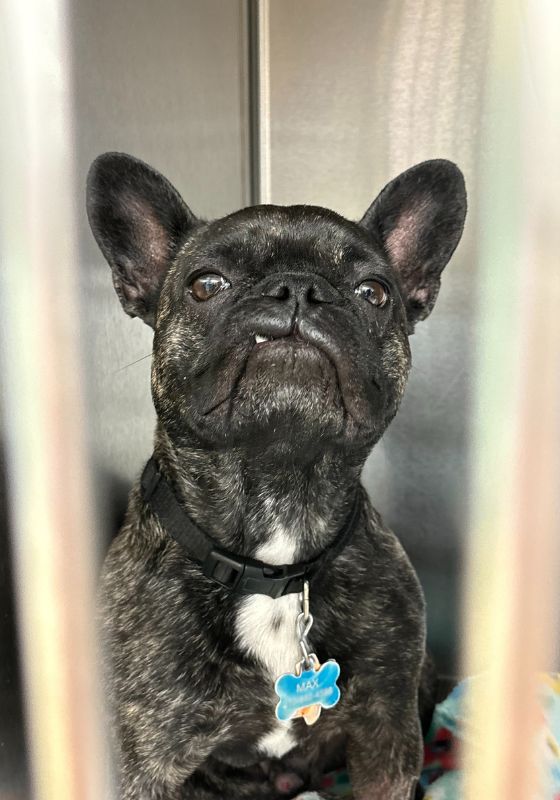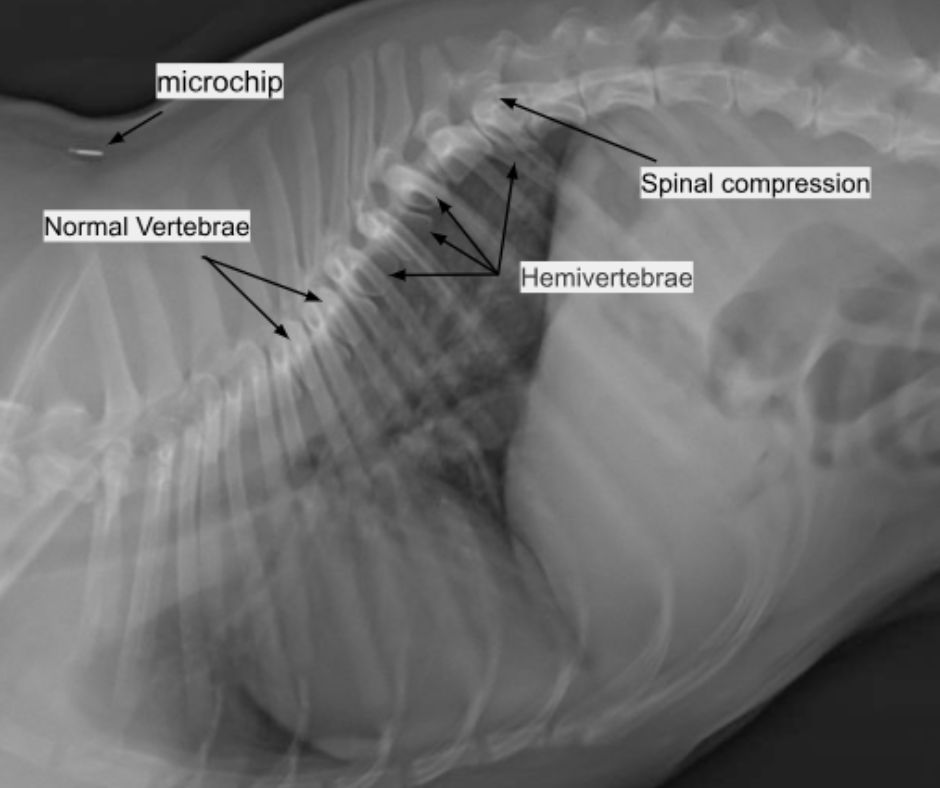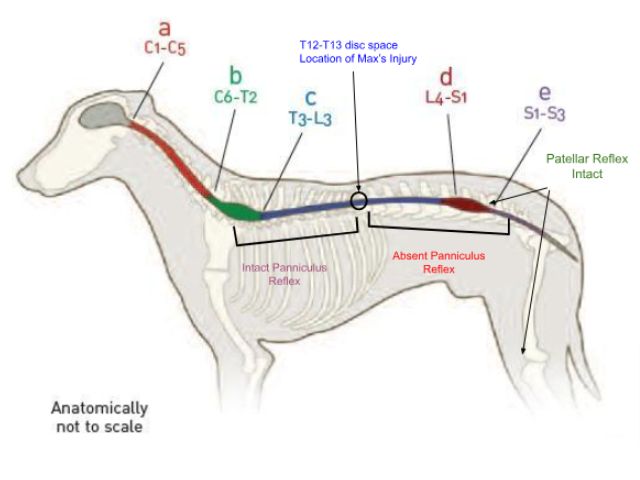The Patient
Max is a 3-year-old male neutered French Bulldog that presented to Belton Veterinary Clinic on emergency for acute hind limb paralysis. Max is a young, energetic dog that loves running around the house and jumping up and down from furniture and the back porch. One day, Max’s parents noticed he was having trouble walking and was panting very hard, so they took him to the local emergency vet that evening. Max was stabilized at the ER and sent to us for further evaluation the following morning.
The Case
On exam, Max was very anxious, panting hard, and acutely paralyzed in his hind limbs. A neurologic exam was performed on Max to assess him for neurologic deficits and their severity. The results suggested that Max likely sustained an injury to his thoracic spine, causing the acute paralysis. This was supported by X-rays that revealed multiple abnormalities called hemivertebrae along Max’s thoracic spine and a region of spinal compression associated with the hemivertebrae, likely causing acute paralysis. A hemivertebrae is a congenital malformation of the vertebrae; normal vertebrae have a cylindrical shape but hemivertebrae often appear like trapezoids or wedges on X-rays. A hemivertebrae is typically an incidental finding on X-rays, but they can sometimes predispose patients to spinal injuries. Spinal injuries in dogs, especially in predisposed breeds like French Bulldogs and Dachshunds, can have varying prognoses. Some cases can improve with supportive care and cage rest, while others are very severe and require emergency referral to a veterinary neurologist for an MRI and surgery.

The Treatment
Max’s parents decided to treat him medically to see how he responded to treatment. Max was hospitalized on IV fluids and started on sedatives, pain medications and muscle relaxants. We also began daily cold laser therapy on Max’s back. Laser therapy promotes healing in damaged and inflamed tissues, and is especially helpful in cases with back injuries.
The Outcome
The next day, Max started showing signs of rapid improvement, able to stand on his hind limbs and walk with instability.
Several days later, Max looked like a brand new dog and was able to walk with almost no detectable hind limb deficits.
Max was discharged for recovery at home, and his parents brought him to the clinic twice-weekly for six weeks for laser therapy on his back. At home, Max needed to be on strict cage rest and leash walking to prevent him from running or jumping and possibly injuring his back again.
Max’s parents have done an excellent job caring for him during his recovery and are even teaching him to not jump on and off of the couch to prevent these kinds of injuries in the future.
Bonus Content: Max’s Neuro Exam
I performed a neurologic exam on Max to assess the severity of his injury and to gain a better idea of his prognosis with different treatment options. I’ll discuss what each test does and what the result means for Max’s case.
| Test | Left Hind Limb | Right Hind Limb |
|---|---|---|
| Conscious Proprioception | Absent | Absent |
| Patellar Reflex | Intact | Intact |
| Deep Pain Perception | Intact | Intact |
| Panniculus Reflex | Absent up to thoracic spine | |
Conscious proprioception tests a patient's ability to place and know where their feet are in space. This test is performed by flipping their feet over placing it on the ground to see if the patient can accurately flip the foot back over and stand on it in an appropriate matter of time. In this case, Max failed to flip both hind feet back over and stand on either foot. This means that Max likely has an injury to his nervous system along his spine between his legs and brain.
The patellar reflex is very similar to when the doctor uses a reflex hammer on your knee to make your leg kick. We test this reflex in dogs to check if their spinal reflexes are working correctly. A spinal reflex is a very fast nervous reaction that is completely contained within the neurons of the spine, so the body is able to react to a stimulus without communicating with the brain. What this means for Max is that the section of his spine that contains the neurons that control movement of his hind limbs likely did not sustain an injury.
The deep pain perception test is one of the most important when assessing dogs for spinal injury as the loss of feeling deep pain indicates the injury is very serious. This test is typically performed by squeezing a toe on the affected leg to see if the patient is able to pull the leg away from the cause of pain. In Max’s case, he was able to feel deep pain and retract his leg, indicating that he still had motor function to his hind limbs and could feel pain despite the spinal injury. Patients that fail this test are often quickly referred to a veterinary neurologist as the case is likely to be very severe and may require surgery.
The panniculus reflex tests where the location of a spinal injury may have occurred. This test is performed by using hemostats to pinch the skin along both sides of the spine. The sharp pain of the pinch causes the skin to twitch in uninjured sections of skin along the spine. The nerves to each section of skin come directly off the spinal cord at each vertebrae; an injury along the spinal cord will cause the reflex to be absent “downstream” from the injury. In Max’s case, he had no panniculus reflex along his lumbar spine, but the reflex was intact along his thoracic spine, likely indicating a spinal injury in his lower thorax. This neurologic exam finding was supported by Max’s X-rays as there was a section of spinal compression at the T12-T13 disc space.
In review, this simple series of tests gave us valuable information about the severity of Max’s spinal injury and even helped us locate where along the spine the injury occurred before we performed X-rays.



